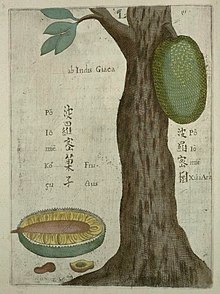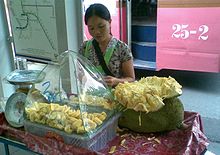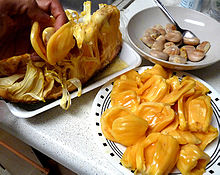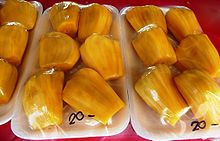Jackfruit tree
| Jackfruit tree | ||||||||||||
|---|---|---|---|---|---|---|---|---|---|---|---|---|

The jackfruit grows directly on the trunk of the tree |
||||||||||||
| Systematics | ||||||||||||
|
||||||||||||
| Scientific name | ||||||||||||
| Artocarpus heterophyllus | ||||||||||||
| Lam. |
The jackfruit tree ( Artocarpus heterophyllus ) is a species of plant in the mulberry family (Moraceae). The fruit is jackfruit , even Jack tree fruit , jackfruit , in Brazilian Portuguese Jaca and Malay Nangka called.
Similar fruits come from the Cempedak tree ( Artocarpus integer ), Arthocarpus rigidus and Artocarpus odoratissimus , but the fruits can also be used by many wild Arthocarpus species; Artocarpus lakoocha is occasionally cultivated.
designation

The name "jackfruit" is said to come from the Malayalam word ചക്ക ( Chakka ). Hendrik van Rheede (1636–1691) mentioned the tree in his work Hortus Malabaricus, published in Amsterdam from 1678–1693, in Dutch transcription ( Tsjaka-Maram ). The name came into English through the work Colóquios dos simples e drogas da India by the Portuguese Garcia da Orta , published in Goa in 1563 .
description

Vegetative characteristics
Artocarpus heterophyllus grows as an evergreen tree , which has a relatively short trunk with a dense treetop , but easily reaches heights of growth of 10 to 20 meters and trunk diameters of 30 to 80 or more (200-300) centimeters. Buttock roots can sometimes be formed. The bark of the jackfruit tree is reddish-brown and smooth, if the bark is damaged, milky sap escapes .
The alternate, helically arranged, somewhat rubbery and thick leaves are divided into a petiole and a leaf blade. The petiole is 1 to 3 inches long. The leathery leaf blade is 7 to 15 (up to 20 centimeters) long, 3 to 7 centimeters wide and elliptical to obovate. The leaves on young trees are irregularly lobed to split. On older trees, the leaves are whole, dark green with a smooth leaf edge and rounded to pointed. The leaf blade has a prominent main nerve and, based on it, six to eight lateral nerves on each side. The stipules are egg-shaped with a length of 1.5 to 8 centimeters.
Generative characteristics
The annual inflorescences are formed on the trunk, branches or twigs ( cauliflora ). Jackfruit trees are single sexed ( monoecious ): A tree bears both female and male flowers . The stalked, cylindrical to ellipsoidal or pear-shaped, long to about 10 to 12 centimeters and 5-7 centimeters wide inflorescences are initially falling completely into the fast, egg-shaped cover sheets wrapped. The flowers are very small, there are several thousand flowers in one inflorescence, which sit on a club-like, fleshy rachis . The male flowers are greenish, some flowers are sterile. The male flowers are hairy and the perianthral tube ends with two 1 to 1.5 millimeter large lobes. The individual and protruding stamens, with yellow, round and two-height anthers, are straight in the bud. After the pollen has been released, the stamens fall off after a few days and then turn ash gray, and later all the male inflorescences also fall. The greenish female flowers, with hairy and röhrigem perianth, have a fleshy bloom soil . The female flowers contain a einfächerigen ovary with a protruding pen with broad, capitate or rarely zweilappiger scar. The flowering period extends from December mostly February to March.
fruit
The ellipsoidal to roundish fruit associations from the fleshy perianth , the actual jackfruit, grow on a long and thick stem on the trunk, are of different sizes and range from an initially yellowish-greenish to yellow, when ripe, yellowish-brown, hard, rubber-like skin with small pimples surrounded, with hard, conical, hexagonal, more or less pointed tubercles . The very large and differently shaped fruit clusters have a length of 30 to 100 centimeters and a diameter of 15 to 50 centimeters and can weigh up to 50 kilograms or more. A fully grown tree produces up to 700 fruits per year, weighing between 0.5 and 50 kg. On average, a maximum of 50 to 80 tons of fruit per hectare are harvested annually on jackfruit tree plantations.
They consist of a firm, fibrous, whitish core (rachis) about 5–10 centimeters thick and many individual fruits (fruitlets, bulbs, pips) up to 10 centimeters long with narrow-elliptical to egg-shaped, light brownish achenes that are about 3 centimeters and a diameter of 1.5 to 2 centimeters. There can be about 100-500 seeds per fruit. The seed coat consists of a thin, leathery-waxy, later thicker, parchment-like and easily detachable testa (husk) and a brownish, membranous tegmen, the cotyledons are usually unevenly large, the endosperm is minimal. The fruit bandage ripens during the rainy season from July to August. The bean-shaped achenes of the jackfruit are covered with a firm yellowish aril (seed coat, pulp), which has an intensely sweet taste when the fruit is ripe. The pulp is enveloped by many narrow fiber strands (rags, perigones; undeveloped perianth), which run between the hard skin to the core of the fruit and are firmly connected to it. When incised, the inner part (core) secretes a very sticky, milky secretion that can hardly be removed from the skin with water and soap, but with oil or other solvents. To clean the hands after "rinsing" the pulp, hold z. B. Street vendors in Tanzania , who sell the fruit in small segments, prepare small bowls of petroleum for their customers so that they can clean their sticky fingers.
An average fruit consists of 27% edible seed coat, 15% edible seeds, 20% white pulp (undeveloped perianth, rags) and rind and 10% seeds. When trees produce too much medium-sized fruit, a good part of it is usually removed; this allows the other fruits to grow larger and develop better to maturity.
Chromosome number
The number of chromosomes is 2n = 56.
distribution
The jackfruit tree is cultivated in all tropical areas of the world. Is home Artocarpus heterophyllus in India, where he worked in the Eastern and Western Ghats occurs at altitudes of 1100 meters. The main growing countries are India, Bangladesh , Thailand , Indonesia , Sri Lanka and Nepal . In India, the main growing areas are in Kerala , Karnataka , Assam and West Bengal .
Taxonomy
The first publication of Artocarpus heterophyllus was made in 1789 by Jean Baptiste de Lamarck Monnet in Encyclopédie Méthodique, Botanique , 3, S. 209. synonyms for Artocarpus heterophyllus Lam. are: Artocarpus integrifolia L. f. , Artocarpus jaca Lam. , Artocarpus integrifolius auct. non L. f.
Cultivation and harvest
The tree thrives on deep, nutrient-rich soils in a humid tropical climate. It is usually planted as a single tree in orchards, often in mixed culture with other fruit trees. Larger pure stocks are the exception. Established varieties have not yet been described. The ripening fruits are often wrapped in bags or wickerwork to protect them from animal damage. The cultivation usually takes place directly from the seeds. Unripe harvested fruits can be kept for up to six weeks, while ripe fruits must be consumed immediately. Because of their enormous size, the fruits are usually sold piece by piece at the local markets.
use
| country | Production * (1000 tons, with year) |
|
|---|---|---|
|
|
1436 (1992) | |
|
|
1005 (2010) | |
|
|
392 (1987) | |
|
|
340 (1987) | |
|
|
k. A. * | |
|
|
19 (2010) | |
|
|
13 (1987) | |
| *) The figures are from very different years and therefore only give an approximate idea. According to this source, no figures are available for Sri Lanka, where probably more jackfruit is harvested than in Nepal. | ||
The fruits are used in South and Southeast Asian cuisine. The unripe fruits are peeled and prepared like vegetables in various cooked dishes or pickled as an Indian pickle . A well-known Javanese specialty is Gudeg , a mild-tasting dish with coconut milk , chicken and spices. Since 2016, the unripe fruits have also been increasingly exported as a vegan meat substitute , as the consistency of the fibers in the fruit after cooking is similar to low-temperature roasted meat .
The fruits, which are dried in the sun, are also sold as jackfruit chips. In many provinces of Thailand, award-winning products are manufactured for export as part of the One Tambon One Product program . Jackfruit is also picked when raw and ripe and consumed as a dessert. The inner yellowish flesh is removed and cored.
Jackfruit seeds (jacknuts) can be eaten cooked or roasted and are used, for example, as an ingredient in curries . Roasted and dried seeds are also processed into flour and used for baking; they taste similar to chestnuts (chestnuts).
The wood of the jackfruit tree is medium-hard, weather-resistant, termite-resistant and can be polished well. It is highly valued as furniture wood and also processed into musical instruments. In Indonesia ( Indonesian pohon nangka ) they are used to build frames for some gong games or the Kendang barrel drum in gamelan , the plucked gambus , and in India the Maddale barrel drum, among other things .
In the southern Indian state of Kerala , this wood is used to build the local cylinder drum Chenda or, in some cases, the hourglass drum Idakka . In this area the tree ( malayalam varikka plavu ) is considered sacred and the residence of the Hindu goddess Kali . Therefore, altar portraits of the goddess and the crown for the main actor in the religious dance drama Mutiyettu are ritually made from jackfruit wood.
By boiling the wood, a yellow dye can be obtained, which is traditionally used to dye the robes of Buddhist monks.
All parts of the tree (pulp, seeds, milk juice, root brew, ...) are used in traditional medicine.
See also
- Gac fruit ( Momordica cochinchinensis )
literature
- Zhengyi Wu, Zhe-Kun Zhou & Michael G. Gilbert: Moraceae in der Flora of China , Volume 5, p. 31: Artocarpus heterophyllus - online (section description).
- Abdul Ghafoor: Moraceae in the Flora of Pakistan : Artocarpus heterophyllus - online (section description).
- KC Sahni: The Book of Indian Trees. Second Edition, Bombay Natural History Society, Oxford University Press, 2000, 2015, ISBN 0-19-564589-8 .
Web links
- Artocarpus heterophyllus (jackfruit) (PDF; 902 kB), Species Profiles for Pacific Island Agroforestry, April 2006.
- Artocarpus heterophyllus from Useful Tropical Plants, accessed May 24, 2018.
Individual evidence
- ↑ a b Hendrik Adriaan van Rheede tot Draakestein: Horti Indici Malabarici Pars Tertia de Arboribus Regni Malabari . Amsterdam 1682, Tsjaka-Maram sive Jacca vel Jaaca, p. 17-20 (Latin, online ).
- ↑ Garcia da Orta: Classificação botanica das plantas e drogas, descriptas nos "Coloquios da India" de Garcia d'Orta . Ed .: DG Dalgado. Nicol's Printing Work's, Bombay 1894, Col. XXVIII. Da jaca, e dos jambolões, e dos jambos, S. 15 (Portuguese, online - edited new edition of Garcia da Orta's work).
- ↑ a b D. KN G Pushpakumara: Floral and Fruit Morphology and Phenology of Artocarpus heterophyllus Lam. (Moraceae). In: Sri Lankan J. Agric. Sci. Vol. 43, 2006, pp. 82-106, online (PDF), at researchgate.net, accessed on May 24, 2018.
- ↑ a b c Amrik Singh Sidhu: APAARI. 2012 Jackfruit Improvement in the Asia-Pacific Region: A Status Report . Ed .: Asia-Pacific Association of Agricultural Research Institutions. Bangkok (English, pdf ).
- ^ N. Haq: Jackfruit Artocarpus heterophyllus. International Center for Underutilized Crops, 2006, ISBN 0-85432-785-1 , pp. 4-11, 72 f.
- ↑ Elhadi M Yahia: Postharvest Biology and Technology of Tropical and Subtropical Fruits. Vol. 3, Woodhead, 2011, ISBN 978-1-84569-735-8 , pp. 275-295.
- ^ Artocarpus heterophyllus at Tropicos.org. In: IPCN Chromosome Reports . Missouri Botanical Garden, St. Louis.
- ↑ a b Artocarpus heterophyllus at Tropicos.org. Missouri Botanical Garden, St. Louis.
- ↑ a b c Bernd Nowak, Bettina Schulz: Pocket dictionary of tropical useful plants and their fruits . Verlag Quelle & Meyer, Wiebelsheim 2009, ISBN 978-3-494-01455-5 , p. 81 .
- ↑ Is this the perfect meat substitute for vegans? Retrieved September 9, 2017 .
- ↑ Award-winning jackfruit chips from Lampang (in Thai).
- ↑ Award-winning jackfruit chips from Prachinburi (in Thai).
- ^ Purdue University: "Jackfruit". Retrieved May 30, 2016 .
- ↑ Frederic Rosengarten Jr .: The Book of Edible Nuts. Dover Pub., 1984, ISBN 0-486-43499-0 , pp. 294 f.




